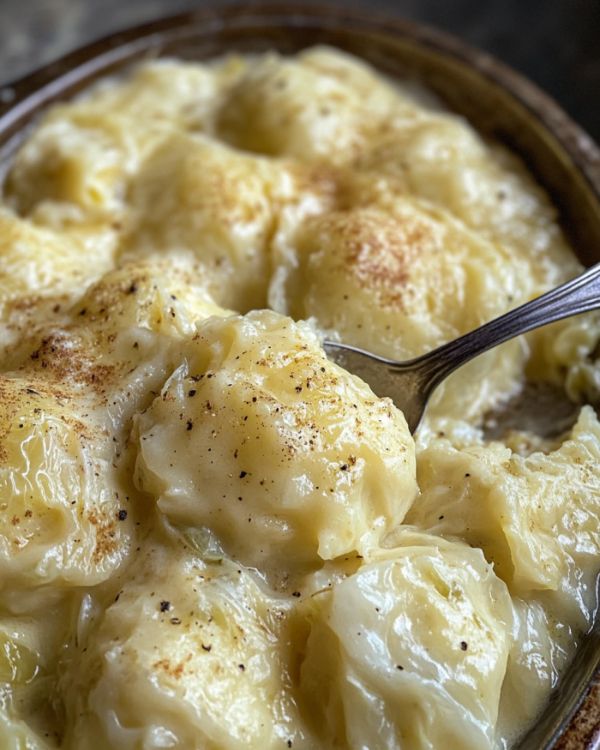Traditional German Cabbage and Dumplings Recipe: A Comforting Classic
Introduction: A Taste of Home with Cabbage and Dumplings
There’s something about a hearty, home-cooked meal that instantly brings comfort, especially when it’s rooted in tradition. If you’ve ever sat down to enjoy a plate of German cabbage and dumplings, you know the warmth that spreads through your body after the first bite. It’s a dish that doesn’t just fill your stomach but your heart, too—evoking memories of family gatherings, warm kitchens, and the simple joy of good food. Whether you’re exploring this recipe for the first time or recreating a nostalgic meal from your childhood, the rich flavors of cabbage, bacon, onions, and tender dumplings are sure to satisfy.
In this article, you’ll learn everything you need to know about crafting this classic dish in your kitchen—from its roots in German cuisine to step-by-step instructions that make the process approachable and fun. So, let’s get started on this delicious journey!
What Are German Cabbage and Dumplings?
The Rich History of German Cabbage and Dumplings
The combination of cabbage and dumplings is a staple in many German households. Rooted in frugality and tradition, this dish evolved out of necessity—using simple, affordable ingredients that were widely available. Over time, cabbage and dumplings have come to symbolize comfort and family, often passed down through generations. These dishes were prepared as a way to stretch ingredients, making a filling meal out of minimal resources, but their flavor is anything but modest.
Today, cabbage and dumplings remain a beloved dish across Germany and beyond, with regional variations adding unique touches to the recipe.
Ingredients Breakdown
Here’s a closer look at the ingredients that make this dish so memorable:
- Cabbage: The star of the show, shredded green cabbage adds texture and a slightly sweet, earthy flavor. Savoy cabbage is also an excellent alternative if you prefer a more tender leaf.
- Bacon: Adds a smoky, savory depth to the dish. If you’re looking for a meat-free option, you can substitute butter or olive oil and add smoked paprika to mimic that rich, smoky taste.
- Onions: These enhance the overall flavor with a mild sweetness and help tie all the elements together.
- Dumplings: Whether you opt for potato-based, bread dumplings (Semmelknödel), or flour-based dumplings, these little bites are soft and satisfying.
- Caraway Seeds: Optional, but they offer a unique twist of flavor that complements the cabbage.
- Butter: Adds richness and ensures everything cooks down perfectly.
- Salt and Pepper: Simple, essential seasonings to balance the flavors.
Ingredient Table
| Ingredient | Amount | Notes |
|---|---|---|
| Green Cabbage | 1 large | Shredded |
| Bacon | 6 strips | Chopped |
| Onions | 2 medium | Thinly sliced |
| Dumplings | 12-14 | Homemade or store-bought |
| Caraway Seeds | 1 tsp | Optional, adds depth |
| Butter | 2 tbsp | For sautéing |
| Salt & Pepper | To taste | For seasoning |
How to Make German Cabbage and Dumplings: Step-by-Step
Now that you’re familiar with the ingredients, let’s walk through the process of creating this heartwarming dish.
Preparing the Cabbage
Start by shredding your cabbage into thin, uniform strips. Heat a large skillet over medium heat and add the chopped bacon. Cook until crispy, then remove the bacon and set it aside. Add the butter to the skillet, followed by the sliced onions, and cook until they soften and become translucent.
Next, add the shredded cabbage to the skillet, stirring it in with the onions and butter. Season with salt, pepper, and caraway seeds if you’re using them. Allow the cabbage to cook down for about 10-15 minutes, stirring occasionally, until it becomes tender but still retains some bite. Once cooked, mix the bacon back into the cabbage and set the mixture aside while you prepare the dumplings.
Perfecting the Dumplings
Dumplings come in different forms, and each one brings a slightly different texture and flavor to the dish. Here’s a quick rundown of the three most popular types you can use:
- Potato Dumplings (Kartoffelklöße): These are soft and slightly chewy, perfect for soaking up all the juices from the cabbage.
- Bread Dumplings (Semmelknödel): Light and fluffy, these are a great way to use up stale bread, adding a rustic feel to the meal.
- Flour-Based Dumplings: Simple and quick to make, these dumplings are a go-to for when you want a no-fuss option.
To make your dumplings from scratch, follow the recipe that suits your choice, or opt for a store-bought version if you’re short on time. Boil the dumplings in salted water until they float to the top, signaling they’re ready to be removed.
Combining Flavors: Cabbage and Dumplings Together
Once your dumplings are ready, it’s time to bring everything together. Plate the dumplings, then spoon the cabbage and bacon mixture over the top. The savory, slightly tangy cabbage pairs perfectly with the soft dumplings, creating a balanced and satisfying bite every time.
Why German Cabbage and Dumplings Are Perfect for Any Occasion
Health Benefits of Cabbage
Cabbage is more than just a tasty vegetable—it’s packed with nutrients that offer several health benefits. Rich in vitamins C and K, cabbage supports a healthy immune system and promotes good digestion. It’s also high in fiber, helping you feel full and satisfied without overeating.
Budget-Friendly Comfort Food
If you’re looking for a meal that doesn’t break the bank, this is it. Cabbage and dumplings rely on affordable ingredients that can be found year-round, making it an excellent option for families or anyone cooking on a budget. You don’t need fancy, expensive ingredients to make something delicious—this dish is proof of that.
Versatile and Customizable
One of the best things about German cabbage and dumplings is how easily you can adapt it to your taste. Want to add more protein? Toss in some smoked sausage or ham. Prefer a vegetarian version? Swap out the bacon for butter or oil, and sprinkle in some smoked paprika for a hint of that same smoky flavor.
Common Questions About Cabbage and Dumplings (FAQ)
What type of dumplings are best for this dish?
Potato dumplings are the most traditional, offering a soft, chewy texture that contrasts beautifully with the tender cabbage. However, bread dumplings and flour-based dumplings are equally delicious, depending on your preference.
Can I make this dish ahead of time?
Absolutely! You can prepare both the cabbage and dumplings in advance and store them in the refrigerator for up to 3 days. To reheat, warm the cabbage in a skillet and steam the dumplings until heated through. Both components also freeze well, making this dish a great option for meal prep.
How do I keep the dumplings from falling apart?
To ensure your dumplings hold together during cooking, make sure you follow the recipe carefully—particularly when it comes to binding ingredients like eggs or starch. Additionally, chilling the dumplings before boiling can help them firm up and stay intact.
Are there regional variations of cabbage and dumplings?
Yes! Different regions in Germany have their own take on this classic dish. For example, in Bavaria, bread dumplings are more common, while in other areas, potato dumplings reign supreme. Some variations also include additional ingredients like sausage or caraway seeds.
Conclusion: Bringing Comfort to Your Table with Cabbage and Dumplings
At the heart of every great meal is the sense of warmth and togetherness it brings. German cabbage and dumplings are more than just a dish—they’re a comforting reminder of home, family, and tradition. Whether you’re new to this recipe or revisiting it with fond memories, it’s a meal that delivers both flavor and comfort.
Now, it’s your turn to try it out. Gather your ingredients, follow the steps, and enjoy the rich, satisfying flavors of this German classic. And don’t forget to share your experience or any creative twists you made to the recipe. Let’s keep the tradition alive—one delicious bite at a time.
Related Recipes You Might Enjoy
- Sauerbraten
- German Potato Salad
- Sauerkraut and Bratwurst

